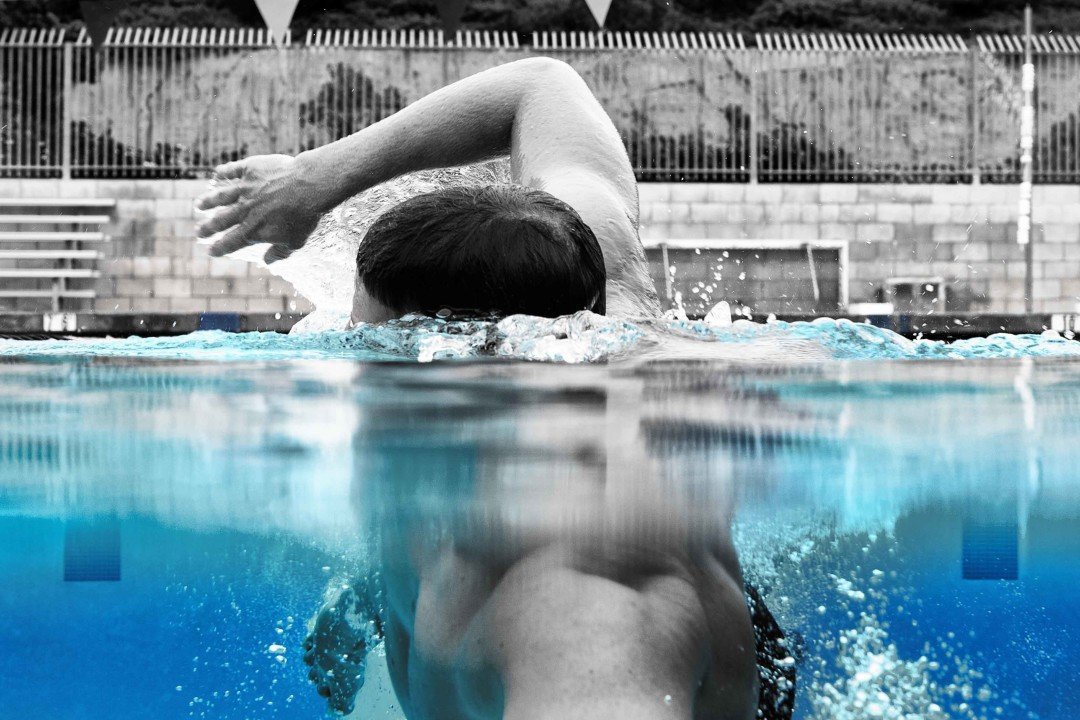Courtesy of Gary Hall Sr., 10-time World Record Holder, 3-time Olympian, 1976 Olympic Games US Flagbearer and The Race Club co-founder. (Swimmer in photo: George Bovell)
Swipping is a conjoining of the words Swimming and Slipping. Swipping is a new word I invented to describe swimming with the least amount of frontal drag possible.
In each passing year that I teach swimming technique at The Race Club, I gain more appreciation for the importance and the sensitivity of frontal drag to the swimmer. Because our sport takes place mostly in water, which is some 800 times denser than air, the forces of drag come into play at much lower speeds. Further, minute changes in body or arm or leg position can lead to significant increases or decreases in frontal drag. Swimming is indeed a sport of minute details.
For the most part, elite athletes, competing at the highest levels of our sport, have learned how to swip rather than swim through the water. Either through a process of trial and error, good coaching, a better feel for the water, or some combination of all three, these athletes have learned how to get through the water with a lower amount of frontal drag. While they are also quite powerful, it is the former quality, rather than the latter, that may have led to their ability to win races.
The real challenge of learning to swip, rather than swim, is that swimmers don’t feel the frontal drag forces as they are moving through the water. Typically, they feel the propulsive or lift forces on their hands, or if they really concentrate, they may feel forces against their feet as they are kicking. That is about it. Unfortunately, the positions of maximum propulsive power are not the same as those of minimal frontal drag. Consequently, most swimmers fall into the power trap. That is, they swim, instead of swip.
The high elbow pull in freestyle is a good example of learning to swip. While the deeper arm pull produces more propulsive power, the speed of the swimmer, which is determined by the propulsive forces minus the drag forces, ends up being slower (over the longer distances) than while using the high elbow pull. The high elbow pull is like the skate boarder cruising down the street who keeps tapping the asphalt backward with his foot to maintain his speed. He goes a lot faster and with less effort than the skateboarder who slows down nearly to a stop and has to push really hard with his foot to regain the speed over and over again. The tapping skateboarder is not only using less energy but is also taking advantage of the law inertia to stay in a more constant motion.
There are many other examples of swipping through the water, but the important point is that it doesn’t take much to change from a swip to a swim. Swimming is a sport of millimeters, tenths of seconds and degrees. Drop the elbow a few millimeters and the drag jumps way up. Begin the breaststroke pull a few tenths of a second too early and the drag during the kick goes way up. Reduce the external rotation of the hip by a few degrees so the knees must be wider on the breaststroke kick and the drag goes way up.
We don’t expect coaches to have the time or ability to spot every detail of stroke technique during a crowded workout. It is hard enough just to keep swimmers on the right intervals. That is what we do at The Race Club. We pay attention to the details above water and below water. We turn swimmers into Swippers.
Join the conversation on this #swimisodes of How to Pull in Freestyle: http://www.theraceclub.com/videos/swimisodes-freestyle-how-to-pull-underwater/
Yours in Swimming,
Gary Sr.

Gary Hall, Sr., Technical Director and Head Coach of The Race Club (courtesy of TRC)
Like The Race Club on Facebook
Follow The Race Club on Instagram
Follow The Race Club on Twitter
Connect to The Race Club / Gary Hall Sr. on Linkedin
THE RACE CLUB
Because Life is Worth Swimming, our mission is to promote swimming through sport, lifelong enjoyment, and good health benefits. Our objective is for each member of and each participant in The Race Club to improve his or her swimming performances, health, and self-esteem through our educational programs, services and creativity. We strive to help each member of The Race Club overcome challenges and reach his or her individual life goals.
 The Race Club provides facilities, coaching, training, technical instruction, video, fitness and health programs for swimmers of all ages and abilities. Race Club swim camps are designed and tailored to satisfy each swimmer’s needs, whether one is trying to reach the Olympic Games or simply improve one’s fitness. Our programs are suitable for beginner swimmers, pleasure swimmers, fitness swimmers, USA swimming or YMCA swimmers, or triathletes; anyone who wants to improve swimming skills. All of our Race Club members share an enjoyment of being in the water and use swimming to stimulate a more active mind and body.
The Race Club provides facilities, coaching, training, technical instruction, video, fitness and health programs for swimmers of all ages and abilities. Race Club swim camps are designed and tailored to satisfy each swimmer’s needs, whether one is trying to reach the Olympic Games or simply improve one’s fitness. Our programs are suitable for beginner swimmers, pleasure swimmers, fitness swimmers, USA swimming or YMCA swimmers, or triathletes; anyone who wants to improve swimming skills. All of our Race Club members share an enjoyment of being in the water and use swimming to stimulate a more active mind and body.

Apologies, but all I hear is ‘swiper, no swipping!’ from Dora the Explorer – thanks to hearing it over and over, and over, again.
Thank you Gary for this great, innovative article. I have just started experimenting with just such things recently, so am glad to see your article & know there are others out there such as yourself paying very close attention. I will certainly incorporate your research into my coaching. Thanks.
If the arm is traveling backwards, relative to the body, at the same rate that the body is moving forward, relative to the water, do you still have frontal drag? The hand and humerus can’t be travel at the same speed relative to the body since they are different distances from the fulcrum (shoulder joint), is this difference in speed relative to the body (and the water) what contributes to the frontal drag of the arm even if the midpoint of the arm obeys the above scenario?
You make a good point, and this is where this “article” is misleading. For most decent freestyle swimmers, the arms are not a significant source of negative drag. The arms are either out front in line with the rest of the body, out of the water, or not moving forward (which would be necessary to create drag). When an arm is pulling, the arm is either moving backwards or (in the case of maximum efficiency) not moving at all. In both cases, the arm is creating POSITIVE drag forces to propel the body forward. Our velocity in the water is a product of the negative drag forces acting against the body versus the positive propulsive forces of lift and drag.… Read more »
FYI, Gary Hall Sr. Charges well over $200/hour for lessons for his armchair theories and incorrect explanations.
Crash is correct in asserting that a swimmers net acceleration or deceleration at any given point is the result of the frontal drag forces and the propulsion forces at that moment. The resultant velocity peak or trough comes shortly after the acceleration peak or deceleration trough. What Crash does not understand is the motion of the pulling arm relative to the water. For most good swimmers, the net velocity of the hand during the pulling motion (with shoulder driven freestyle) is near zero (it enters and leaves at nearly the same point in the water). All points on the arm above the hand have a net forward velocity (during the underwater pull) which increases as we approach the shoulder. At… Read more »
Well said.